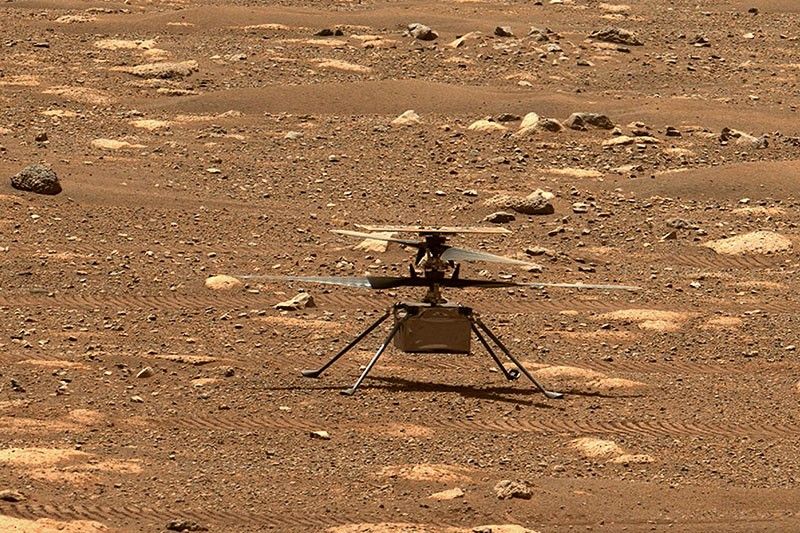NASA aims for historic helicopter flight on Mars

WASHINGTON, United States — NASA is hoping to make history early Monday when the Ingenuity Mars Helicopter attempts the first powered, controlled flight on another planet.
The space agency had originally planned the flight for April 11 but postponed it over a software issue that was identified during a planned high-speed test of the aircraft's rotors.
The issue has since been resolved, and the four-pound (1.8 kilograms) drone could achieve its feat by around 3:30 am Eastern Time (0730 GMT).
Data, however, won't arrive until several hours later, and NASA will begin a livestream at 6:15 am (1015 GMT).
"Each world gets only one first flight," MiMi Aung, the Ingenuity project manager, said before the first attempt.
The first powered flight on Earth was achieved by the Wright brothers in 1903 in Kitty Hawk, North Carolina. A piece of fabric from that plane has been tucked inside Ingenuity in honor of that feat.
The helicopter traveled to Mars attached to the underside of the rover Perseverance, which touched down on the planet on February 18 on a mission to search for signs of extraterrestrial life.
Ingenuity's goal, by contrast, is to demonstrate its technology works, and it won't contribute to Perseverance's science goals.
But it is hoped that Ingenuity can pave the way for future flyers that revolutionize our exploration of celestial bodies because they can reach areas that rovers can't go, and travel much faster.
The timing of the helicopter flight is chosen with the weather on Mars in mind. Wind is the big unknown and could jeopardize the mission.
The flight is challenging because the air on Mars is so thin — less than one percent of the pressure of Earth's atmosphere.
That makes it much harder to achieve lift, even though it will be partly aided by a gravitational pull that is a third of Earth's.
High-res videos
The helicopter will rise for about six seconds, hover and rotate for about 30 seconds, then go back down.
The flight will be autonomous, pre-programmed into the aircraft because of the 15 minutes it takes for signals to travel from Earth to Mars.
Ingenuity itself will analyze its position with respect to the Martian surface.
After the flight, Ingenuity will send Perseverance technical data on what it has done, and that information will be transmitted back to Earth.
This will include a black and white photo of the Martian surface that Ingenuity is programmed to snap while flying.
Later, once its batteries have charged up again, Ingenuity is to transmit another photo -- in color, of the Martian horizon, taken with a different camera.
But the most spectacular images are supposed to come from the rover Perseverance, which will film the flight from a few meters away.
Shortly after this filming, six videos of 2.5 seconds each will be sent to Earth. NASA hopes at least one of them will show the helicopter in flight.
The entire video will be sent over the following few days.
"There will be surprises, and you will be learning about them right at the same time that we will. So let's all get the popcorn," said Elsa Jensen, who oversees the cameras on the rover.
'High risk'
Four outcomes are possible, said Aung: full success, partial success, insufficient or no data coming back, or failure.
If the flight is a success, NASA plans another no more than four days later. It plans as many as five altogether, each successively more difficult, over the course of a month.
NASA hopes to make the helicopter rise five meters (16 feet) and then move laterally.
Ingenuity's "lifetime will be determined by how well it lands" each time, said Aung — meaning whether it crashes.
"Once we get to the fourth and fifth flight, we'll have fun," she said. "We are going to take very bold flights and take high risk."
Monitor major developments on space explorations and the status of missions.
NASA reveals a sample collected from the 4.5-billion-year-old asteroid Bennu contains abundant water and carbon, offering more evidence for the theory that life on Earth was seeded from outer space.
The discovery follows a seven-year-round-trip to the distant rock as part of the OSIRIS-REx mission, which dropped off its precious payload in the Utah desert last month for painstaking scientific analysis.
"This is the biggest carbon-rich asteroid sample ever returned to Earth," NASA administrator Bill Nelson says at a press event at the Johnson Space Center in Houston, where the first images of black dust and pebbles were revealed. — AFP
NASA is set to reveal on Wednesday the first images of the largest asteroid sample ever collected in space, something scientists hope will yield clues about the earliest days of our solar system and perhaps the origins of life itself.
The OSIRIS-REx mission collected rock and dust from the asteroid Bennu in 2020, and a capsule containing the precious cargo successfully returned to Earth a little over two weeks ago, landing in the Utah desert.
It is now being painstakingly analyzed in a specialized clean room at NASA's Johnson Space Center in Houston. — AFP
A Spanish company launches the country's first private rocket on Saturday in a step towards bringing Spain into the exclusive club of space-faring nations.
The launch of the small MIURA1 rocket took place at 02:19 am (0019 GMT) from a military base in the southern region of Andalusia, according to the company, PLD Space.
The company hailed the launch as "successful" and said it had achieved all its "technical objectives". — AFP
India's Sun-monitoring spacecraft has crossed a landmark point on its journey to escape "the sphere of Earth's influence", its space agency says, days after the disappointment of its Moon rover failing to awaken.
The Aditya-L1 mission, which started its four-month journey towards the centre of the solar system on September 2, carries instruments to observe the Sun's outermost layers.
"The spacecraft has escaped the sphere of Earth's influence," the Indian Space Research Organisation (ISRO) says in a statement. — AFP
Carbon dioxide detected on Jupiter's moon Europa comes from the vast ocean beneath its icy shell, research using James Webb Space Telescope data, potentially bolstering hopes the hidden water could harbour life.
Scientists are confident there is a huge ocean of saltwater kilometres below Europa's ice-covered surface, making the moon a prime candidate for hosting extra-terrestrial life in our Solar System.
But determining whether this concealed ocean has the right chemical elements to support life has been difficult. — AFP
- Latest































